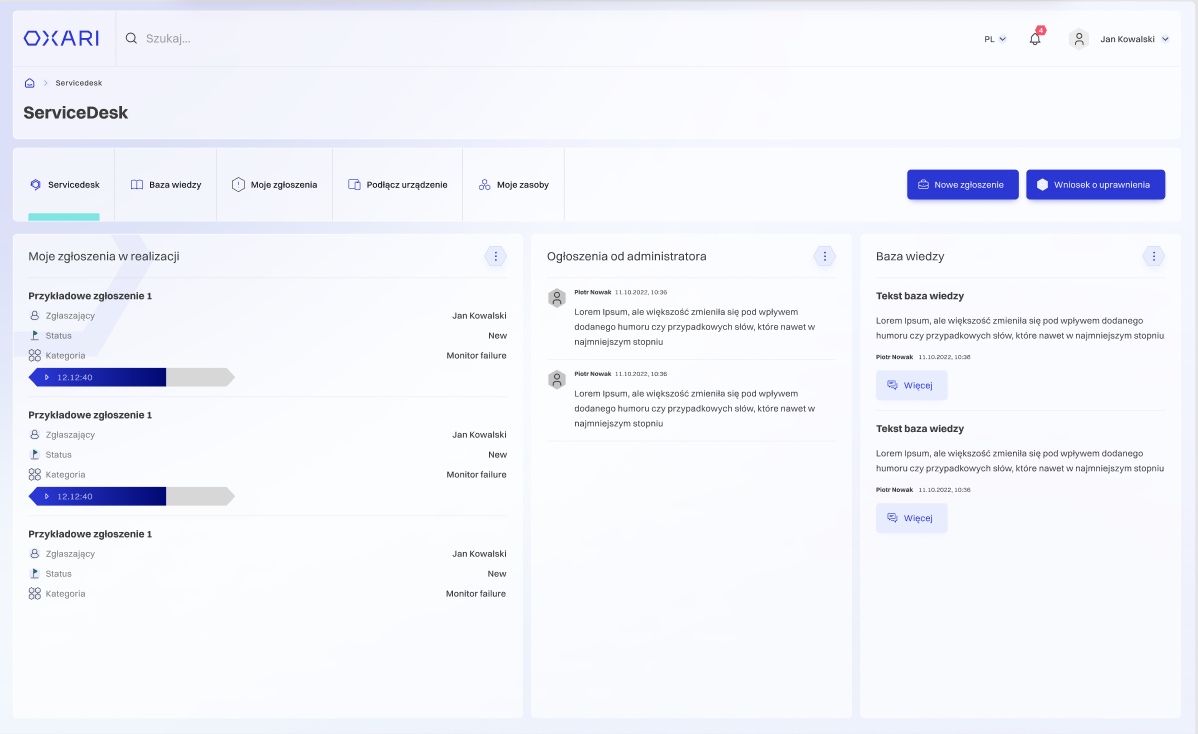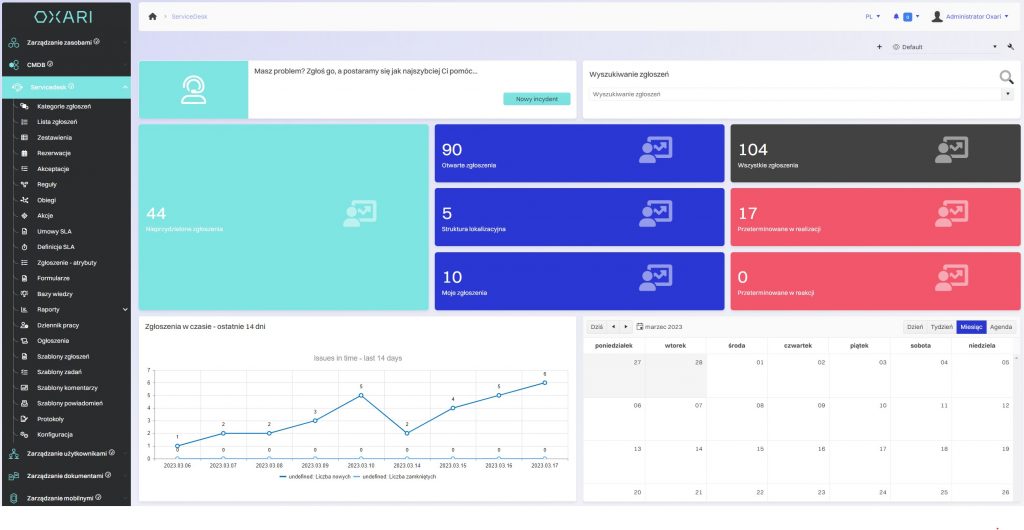Ciągłość działania jednostek biznesowych oraz technicznych to największy priorytet dla każdej organizacji. Wiedza na temat aktualnych usterek, przerw w działaniu usług czy awarii urządzeń, pozwala efektywnie zarządzać procesem naprawy. Wdrożenie systemu obsługi zgłoszeń umożliwia bieżącą analizę i podjęcia działań naprawczych w newralgicznych obszarach firmy. Moduł Service desk to często jedno z narzędzi zawartych we współczesnych systemach klasy IT Service Management.
KORZYŚCI Z PLATFORMY DO OBSLUGI ZGŁOSZEŃ W OTOCZENIU BIZNESOWYM
Ciągłość działania jednostek biznesowych oraz technicznych to największy priorytet dla każdej organizacji. Wiedza na temat aktualnych usterek, przerw w działaniu usług czy awarii urządzeń, pozwala efektywnie zarządzać procesem naprawy.

IT Service Management (ITSM)
Definicja znaczenia terminu IT Service Management określa zbiór informacji na temat zarządzania systemami informatycznymi. Z założenia, podstawowymi elementem infrastruktury jest posiadany sprzęt komputerowy, oprogramowanie, usługi informatyczne oraz wszelkie przetwarzane dane. Głównym odbiorcą opisanych powiązań i zależności jest klient – jako użytkownik końcowy w 100% zależny od dostępności firmowych narzędzi oraz usług IT. System ITSM pozwala więc określić podstawowe procesy organizacji, wskazać osoby odpowiedzialne za poszczególne elementy oraz zaplanować wsparcie dla kluczowych technologii oraz produktów.
Z założenia, ITIL to zestaw uniwersalnych rozwiązań opracowanych dzięki wiedzy i doświadczeniu zdobytych przez użytkowników na całym świecie.

ITIL jako zbiór dobrych praktyk zarządzania
ITIL jako globalny standard praktyk zawiera wytyczne do zarządzania infrastrukturą oraz usługami IT. Rolą przewodnią jest zwiększenie wartości usług organizacji przez rozwiązywanie problemów biznesowych, często niezwiązanych w żaden sposób z IT. Najnowsza wersja 4 promuje usługi jako cyfrowe rozwiązania zapewniające przewagę wśród konkurencji. Z założenia, ITIL to zestaw uniwersalnych rozwiązań opracowanych dzięki wiedzy i doświadczeniu zdobytych przez użytkowników na całym świecie. Każdy zdefiniowany proces czy usługa ma przydzielone role oraz wpływ na organizację. Największą zaletą jest możliwość wdrożenia go w każdej organizacji, niezależnie od prowadzonego rodzaju działalności (branży).
Katalog usług
Katalog usług (service catalog) to bardziej zaawansowana forma wyboru kategorii usterki. Najczęściej są w nim zawarte usługi biznesowe i dla nich są zdefiniowane szczegółowe parametry opisujące (np. ważność usługi, właściciel biznesowy czy ciągłość działania). Katalog usług jest spotykany w większych organizacjach, mających już doświadczenie w pracy z systemami ticketowymi.
Problem management
Zarządzanie problemami jest procesem odpowiedzialnym za zarządzanie cyklem życia wszystkich problemów, które występują lub mogą wystąpić w usłudze IT. Podstawowymi celami zarządzania problemami są: zapobieganie powstawaniu problemów i wynikających z nich incydentów, eliminowanie powtarzających się oraz minimalizowanie wpływu tych, którym nie można zapobiec. ITIL definiuje problem jako przyczynę jednego lub więcej incydentów.
Baza wiedzy
Moduł Servicedesk zawiera również bazę wiedzy (knowledge base) oraz panel ogłoszeń. Funkcjonalność pozwala na prowadzenie wewnętrznej lub publicznej bazy rozwiązań dostępnych dla użytkowników. Przygotowane zagadnienia techniczne są przedstawiane użytkownikom podczas zakładania nowego zgłoszenia serwisowego jako możliwe rozwiązanie problemu. Wewnętrzna baza artykułów ułatwia administratorom rozwiązywanie bardziej złożonych problemów.
Zarządzanie kolejką zgłoszeń w systemie OXARI
Rejestracja nowego zgłoszenia serwisowego jest realizowana przez dedykowane panele WWW. Doświadczenia zdobyte podczas analizy potrzeb i wdrożeń modułu Servicedesk u naszych klientów pozwoliły zaprojektować ergonomiczne i przyjazne interfejsy. W zależności od posiadanej roli, system udostępnia do zarządzania panel użytkownika, administratora oraz managera. Z założenia, użytkownik „biurowy” posiada najprostszy w obsłudze panel help desk. Utworzenie nowego ticketu sprowadza się do określenia kategorii (np. awaria sprzętu, oprogramowania) oraz krótkiego opisu usterki.

Zapisane zgłoszenie trafia do obsługi do dedykowanego opiekuna lub linii wsparcia. Dobrą praktyką jest wdrożenie w organizacji zasady SPOC (single point of contact) jako pierwszej linii wsparcia użytkowników. Podobne incydenty mogą być łączone w problemy i obsługiwane w ramach jednego zadania.

Zarządzanie liniami wsparcia oraz kolejką ticket’ów ułatwia dedykowany panel managera. Aktualny status jest przedstawiony w postaci przejrzystych wykresów oraz raportów dostosowanych do potrzeb. Dzięki analizie ilości incydentów w czasie oraz najczęstszych kategorii usterek możliwe są szybka reakcja zespołu i korekta w istniejącym procesie obsługi.
SLA – czas reakcji i realizacji
Zakończenie procesu rejestracji incydentu może skutkować określeniem czasu realizacji zgłoszenia. Parametrem określającym termin rozwiązania usterki jest SLA (the Service Level Agreement) pozwalający na zarządzanie czasem reakcji oraz czasem realizacji dla wybranej kategorii, priorytetu lub lokalizacji. Jeżeli zgłoszenie zostanie rozwiązane w deklarowanym czasie, zaliczy się jako zgodne z SLA. Okresowa analiza czasu realizacji zgłoszeń (zgodności z SLA) pozwala na określenie jakości świadczonych usług informatycznych. Skrócenie czasu reakcji zespołu IT na usterki firmowych systemów i szybkie usuwanie awarii minimalizuje ryzyko przestojów.
Wdrożenie i konfiguracja modułu
System OXARI pozwala na samodzielną konfigurację logiki pracy modułu Servicedesk oraz dopasowanie zawartości paneli do aktualnych założeń procesu rejestracji zgłoszeń. Po zakończeniu automatycznej instalacji, moduł zawiera predefiniowaną listę kategorii, statusów oraz priorytetów. Ostatnim elementem uruchomienia procesu rejestracji ticket’ów to utworzenie ikony serwisowej na pulpicie userów. W przypadku posiadania usługi katalogowej (Active Directory) aplikacja umożliwia automatyczne logowanie użytkowników (SSO) oraz uzupełnia bazę osobową o adresy e-mail pracowników.
ServiceDesk plus Zarządzanie zasobami
System OXARI za pomocą zdalnych agentów odczytuje informacje sprzętowo-systemowe z zarejestrowanych stanowisk komputerowych. W połączeniu z modułem analizy oprogramowania oraz z modułem zarządzanie zasobami (Asset Management), dział IT naszych klientów otrzymuje pełny zestaw informacji na temat urządzeń powiązanych ze zgłoszeniami. Dostęp do parametrów sprzętu, BIOS, zainstalowanych aplikacji, umów serwisowych czy gwarancji skraca czas rozwiązania problemów i ułatwia pracę administratorom. Narzędzia zawarte w module Zdalne zarządzanie i automatyzacja pozwalają na zdalne usuwanie problemów bez konieczności fizycznej obecności przy stanowisku.
Korzyści z wdrożenia systemu Service Desk
Główne korzyści wynikające z wdrożenia modułu Servicedesk to systemowa obsługa procesu rejestracji zgłoszeń wraz z podniesieniem standardu poziomu dostępności usług firmowych. Wiedza na temat najczęściej zgłaszanych usterek wraz z informacją, jakie firma posiada zasoby, pozwala na elastyczne zarządzanie dostępną infrastrukturą IT. Centrum pomocy technicznej to również ułatwienie użytkownikom kontaktu z inżynierami w zakresie codziennych problemów. Portal Service desk zapewnia również rejestrację zgłoszeń 24/7, poza godzinami pracy działu IT.
Ciągłość działania jednostek biznesowych oraz technicznych to największy priorytet dla każdej organizacji. Wiedza na temat aktualnych usterek, przerw w działaniu usług czy awarii urządzeń, pozwala efektywnie zarządzać procesem naprawy.
Wdrożenie systemu obsługi zgłoszeń pozwala na bieżącą analizę i szybkie podjęcie działań naprawczych w newralgicznych obszarach firmy.


